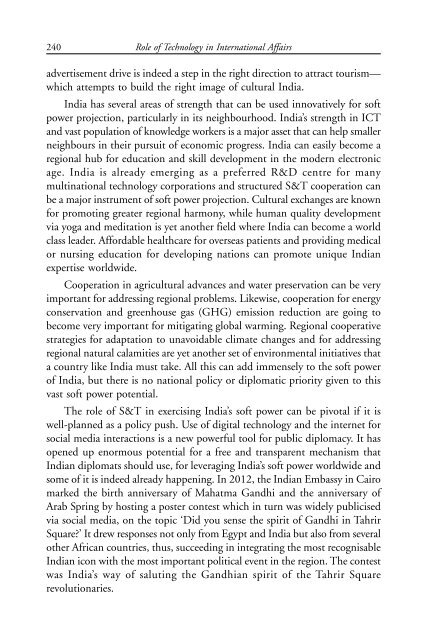ROLE OF TECHNOLOGY INTERNATIONAL AFFAIRS
book_role-of-technology-in-international-affairs_a-mallik_1
book_role-of-technology-in-international-affairs_a-mallik_1
You also want an ePaper? Increase the reach of your titles
YUMPU automatically turns print PDFs into web optimized ePapers that Google loves.
240<br />
Role of Technology in International Affairs<br />
advertisement drive is indeed a step in the right direction to attract tourism—<br />
which attempts to build the right image of cultural India.<br />
India has several areas of strength that can be used innovatively for soft<br />
power projection, particularly in its neighbourhood. India’s strength in ICT<br />
and vast population of knowledge workers is a major asset that can help smaller<br />
neighbours in their pursuit of economic progress. India can easily become a<br />
regional hub for education and skill development in the modern electronic<br />
age. India is already emerging as a preferred R&D centre for many<br />
multinational technology corporations and structured S&T cooperation can<br />
be a major instrument of soft power projection. Cultural exchanges are known<br />
for promoting greater regional harmony, while human quality development<br />
via yoga and meditation is yet another field where India can become a world<br />
class leader. Affordable healthcare for overseas patients and providing medical<br />
or nursing education for developing nations can promote unique Indian<br />
expertise worldwide.<br />
Cooperation in agricultural advances and water preservation can be very<br />
important for addressing regional problems. Likewise, cooperation for energy<br />
conservation and greenhouse gas (GHG) emission reduction are going to<br />
become very important for mitigating global warming. Regional cooperative<br />
strategies for adaptation to unavoidable climate changes and for addressing<br />
regional natural calamities are yet another set of environmental initiatives that<br />
a country like India must take. All this can add immensely to the soft power<br />
of India, but there is no national policy or diplomatic priority given to this<br />
vast soft power potential.<br />
The role of S&T in exercising India’s soft power can be pivotal if it is<br />
well-planned as a policy push. Use of digital technology and the internet for<br />
social media interactions is a new powerful tool for public diplomacy. It has<br />
opened up enormous potential for a free and transparent mechanism that<br />
Indian diplomats should use, for leveraging India’s soft power worldwide and<br />
some of it is indeed already happening. In 2012, the Indian Embassy in Cairo<br />
marked the birth anniversary of Mahatma Gandhi and the anniversary of<br />
Arab Spring by hosting a poster contest which in turn was widely publicised<br />
via social media, on the topic ‘Did you sense the spirit of Gandhi in Tahrir<br />
Square?’ It drew responses not only from Egypt and India but also from several<br />
other African countries, thus, succeeding in integrating the most recognisable<br />
Indian icon with the most important political event in the region. The contest<br />
was India’s way of saluting the Gandhian spirit of the Tahrir Square<br />
revolutionaries.


